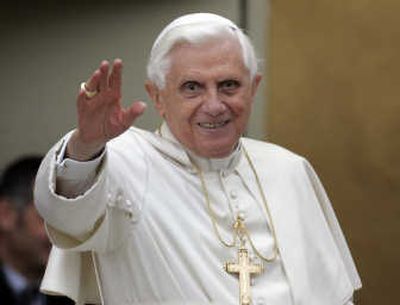Benedict’s visit comes at time of transition

WASHINGTON – To Pope Benedict XVI, experts say, the U.S. Catholic Church is a bit like an adolescent: young and unpredictable.
There are bankrupt dioceses and empty seminaries – yet tens of thousands of laypeople are stepping into the chasm to lead their churches.
One of every 10 American Catholics has left the faith – yet close to half of U.S. Catholics attend Mass at least monthly.
Tens of thousands of Catholics have clamored for tickets to the pope’s Thursday Mass at Nationals Park, yet many more think he’s too rigid – or irrelevant.
But how does Benedict understand this picture?
“At the Vatican, there is an admiration for American religiosity,” said Monsignor Lorenzo Albacete, a theologian. “But there is a question whether American religiosity is strong enough. It appears to be, from the Vatican point of view, content-free, more spiritual high and emotion than a serious question as to what is true and what is not.”
American Catholics can’t agree whether they’re in crisis or renewal. All sides describe a community in dramatic demographic flux. Further, it is divided in key ways, including the importance of male clergy, immigration and the authority of not only Catholicism but Christianity.
Yet to Benedict, a German scholar, America looks religiously vibrant compared to secular Europe, with U.S. politicians touting their religiosity and U.S. courts reaffirming faith’s role in public life.
The fact of his visit shows the importance of the American church to the Vatican. At 80, Benedict travels infrequently; this will be his eighth foreign trip in three years as pope. And American Catholics make up just 6 percent of the world church, a percentage that’s shrinking as the number of Catholics in Africa and Asia booms.
But culturally and financially, Americans loom supersize. For those reasons and others, Benedict experts say, the pope views the United States as an essential battleground in what he considers the war of today’s era: proving that modernity doesn’t have to stamp out religious faith.
It’s well-known that U.S. Catholics disagree with the Vatican on issues of sexuality, including abortion and same-sex marriage. According to recent Washington Post-ABC News surveys, 63 percent of Catholics, compared with 55 percent of all adults, believe gay couples should have access to the same legal protections as heterosexual couples. And 62 percent of Catholics, compared with 57 percent of all adults, say abortion should be legal in all or most cases. Large swaths of Catholics also part ways with Benedict’s teachings on immigration, the Iraq war and capital punishment.
Jose Casanova, a Georgetown University professor who specializes in religion and globalization, says there is a growing segment of American Catholics who are essentially developing their own, individualized religion, in tension with the hierarchy but vibrant and spiritual. He calls it “faithful dissent.”
Some critics believe dialogue in the church has been severely limited by alleged cover-ups of the clergy sex abuse scandal, which has seriously scarred U.S. Catholicism, left thousands of victims emotionally wounded, bankrupted six dioceses and resulted in more than $2 billion in payouts to victims. Many Catholics – and ex-Catholics – cite failed church leadership in the scandal as a source of lost faith.
Top Vatican officials say Benedict will address the crisis, and possibly meet victims, while he’s in the United States, but many advocates are angry he hasn’t been more direct and left the center of the crisis – Boston – off his itinerary.
The U.S. church is changing. Latinos will lead it in new directions, including geographically. That’s because almost three in four Latino Catholics live in the South and West, shifting the center of the U.S. church from the Northeast.
Because of the plummeting number of U.S.-born priests, clergy are increasingly being sent here from places of new growth, such as India. About 35,000 lay ministers, 80 percent of whom are women, keep many parishes running.
“You don’t have to be a math genius to see that somewhere along the line, it doesn’t matter how many you import, this clerical church will look quite different,” said Paul Lakeland, an expert on U.S. Catholic laity.
But some believe the American church is about to right itself. Two orthodox popes in a row have built a clear sense of what is “Catholic,” the thinking goes. Also, the Latino influx “suggests springtime for the American church,” author Michael Sean Winters said. “The Latin American church still generates culture, unlike the American church. It generates art, myth, the things that help people sustain relationships.”
Many Benedict-watchers say he believes the ultimate challenge goes beyond the sex abuse scandal, sociology or politics.
“Christianity is stronger here than anywhere else in the West, but we are at the frontier of the encounter between faith and modernity,” said Albacete, the theologian. “If Catholics can learn how to live here in a way that is reasonable and human and compassionate, it will be a great example for the church. Will we be up to it? I don’t know.”